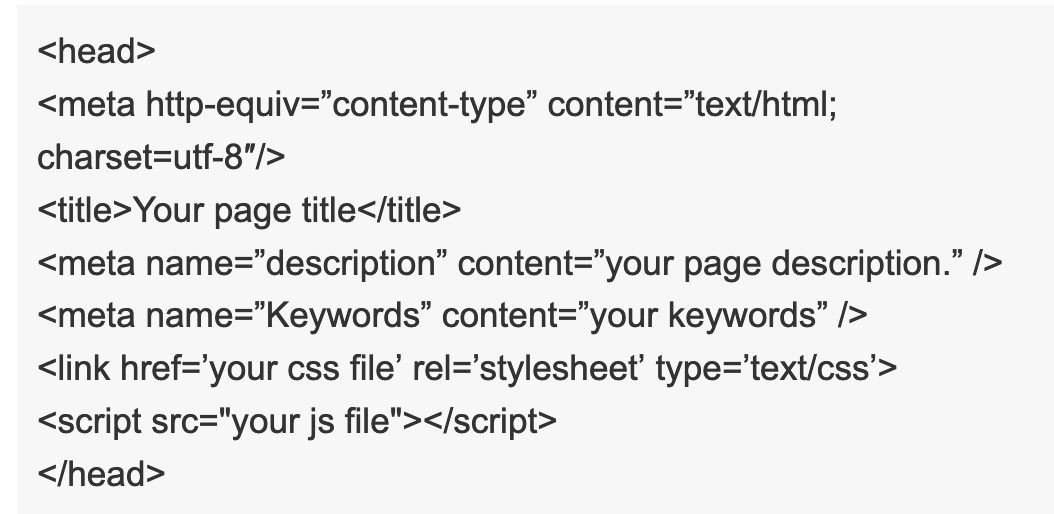Latest update: April 18, 2025
The distinction between various elements can often blur, leaving many to ponder over the purpose and potential of seemingly small details. Among these, the HTML <head> element stands as a testament to the unseen yet crucial backbone of web page functionality and search engine optimization (SEO).
This exploration delves into the anatomy of the HTML <head>, uncovering its pivotal role in the, distinguishing its functions from the visible content within the <body>, and highlighting its indispensable value in SEO strategies. As we navigate through the essence and operations of the <head> element, we unravel the intricacies that make it a cornerstone of successful web development and digital marketing.
What Does Head Do in HTML?
The <head> element orchestrates a range of tasks:
- Defining the page title: Displayed on the browser tab and used by search engines;
- Managing meta tags: Including descriptions that appear in search engine results, keywords for SEO, and viewport settings for responsive design;
- Linking external resources: Such as CSS files for styling and JavaScript files for interactivity.
These functionalities are pivotal in ensuring that a webpage is accessible, user-friendly, and optimized for search engines.
How Important is The HTML Header for SEO?
The <head> section plays a vital role in SEO, offering search engines valuable data that helps determine the relevance and context of a webpage. Proper use of meta tags, structured data, and canonical URLs within the <head> can significantly enhance a site’s visibility and ranking. Additionally, specifying a descriptive title and meta description aids in attracting clicks from search results, making the <head> an indispensable asset for effective SEO strategies.
How to Use meta tags to improve SEO?
Meta tags within the HTML <head> offer a powerful toolkit for webmasters aiming to optimize their site’s search engine visibility. By meticulously crafting meta descriptions, keywords, and author tags, developers can directly influence how search engines interpret and display their web pages in search results. This strategic use of meta tags not only aids in accurately categorizing content but also enhances the appeal of search listings to potential visitors, significantly impacting click-through rates and overall website traffic.
For developers seeking to further optimize their webpages and page performance, Google’s Search Developers site offers a treasure trove of resources and best practices. Explore Google’s official documentation to uncover advanced techniques and guidelines that can help refine your HTML structure, including the head section, for optimal search engine visibility and speed.
Optimizing for Performance with Resource Links
The inclusion of external CSS and JavaScript files in the <head> is a delicate balancing act between functionality and performance. While these links are crucial for defining the aesthetic and interactive aspects of a web page, they also require careful optimization to prevent slow loading times. Techniques such as minifying files, using asynchronous loading for non-critical JavaScript, and leveraging modern CSS loading strategies can dramatically improve page load speeds, contributing to a smoother user experience and better search engine rankings.
HTML Document Head – Ordering Elements for Page Speed
The <head> area of an HTML document is a treasure trove of crucial information for both web browsers and search engine spiders. It houses the page title, meta data such as descriptions and keywords, and calls to external CSS or JavaScript files. Given the weight of its contents, it’s surprising that the organization of the head section is frequently neglected, leading to potential delays in page rendering.
The Head Element
To kick things off, let’s begin with the opening <head> tag:
<head>Character Encoding
Immediately following the head opening tag, specify the character encoding. This crucial step informs the browser about the text encoding format of your webpage:
<meta http-equiv="content-type" content="text/html; charset=utf-8"/>This encoding tag is vital for the browser to properly render your page without having to guess the character set, enabling it to move forward efficiently.
Title and Description
The title and description meta tags come next. The title provides a quick identifier for the page, while the description offers a brief overview of the page’s content:
<title>Your page title</title>
<meta name="description" content="your page description." />If you opt to use the keyword meta tag, it should be placed immediately after the description:
<meta name="Keywords" content="your keywords" />External CSS
Prioritizing the loading of CSS is essential. Place your CSS links before any JavaScript calls to allow for parallel downloading of CSS and other resources:
<link href='your css file' rel='stylesheet' type='text/css'>This approach ensures that styling can begin rendering immediately, improving the perceived load time of your page.
External JavaScript
Once your CSS is linked, you can safely include your JavaScript files. Positioning JavaScript calls after CSS ensures that CSS rendering is not blocked by JS execution:
<script src="your js file"></script>Closing the Head
Finally, close the head section:
</head>An Example of Well-Ordered Head Section
Combining all the elements in an organized manner yields a head section optimized for speed and clarity:
<head>
<meta http-equiv="content-type" content="text/html; charset=utf-8"/>
<title>Your page title</title>
<meta name="description" content="your page description." />
<meta name="Keywords" content="your keywords" />
<link href='your css file' rel='stylesheet' type='text/css'>
<script src="your js file"></script>
</head>Conclusion
The HTML <head> element is a silent yet formidable force in the world of web development and SEO. Far from being just a placeholder for technical snippets, the <head> embodies the strategic groundwork necessary for crafting responsive, efficient, and search engine-friendly websites. Through understanding and optimizing the content of the <head>, developers and SEO specialists can unlock the full potential of their online presence, ensuring their websites not only captivate users but also excel in the competitive arena of search rankings.
The journey through the nuances of the <head> element reinforces its status as an integral part of web design, reminding us of the power that lies in the unseen foundations of our digital creations.


